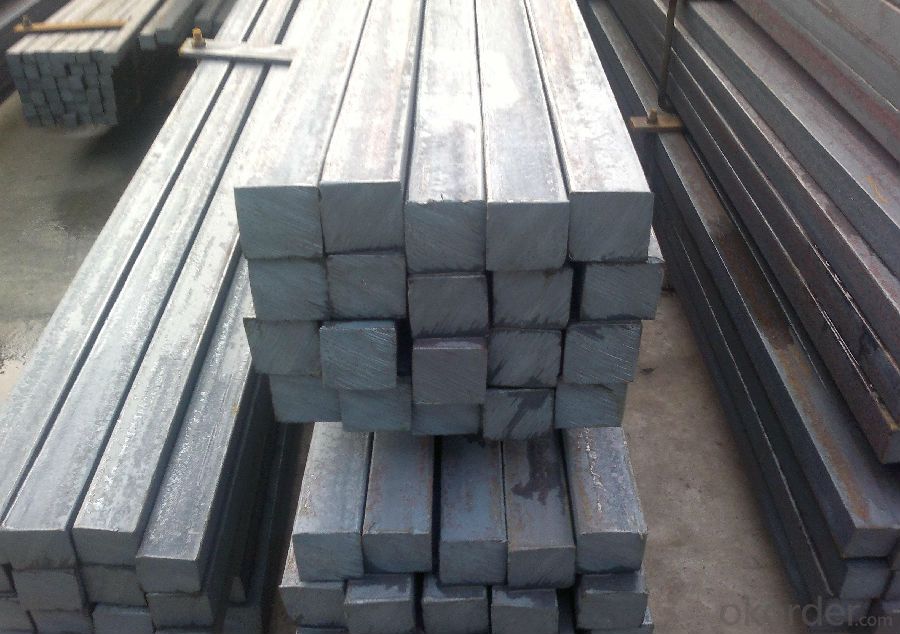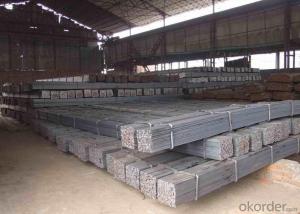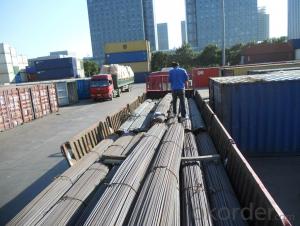Hot Rolled Steel Square Bar with the Size 100mm
- Loading Port:
- Tianjin
- Payment Terms:
- TT OR LC
- Min Order Qty:
- 2000 m.t.
- Supply Capability:
- 20000 m.t./month
OKorder Service Pledge
OKorder Financial Service
You Might Also Like
Product Description:
OKorder is offering Hot Rolled Steel Square Bar with the Size 100mm at great prices with worldwide shipping. Our supplier is a world-class manufacturer of steel, with our products utilized the world over. OKorder annually supplies products to European, North American and Asian markets. We provide quotations within 24 hours of receiving an inquiry and guarantee competitive prices.
Product Applications:
Hot Rolled Steel Square Bar with the Size 100mm can be used as steel billet for other steel products like steel angles, channels, I-beams, H-beams, steel Rebar, steel wire rod etc.
Product Advantages:
OKorder's Hot Rolled Steel Square Bar with the Size 100mm with High Quality are durable, diversified and qualified.
Main Product Features:
· Premium quality
· Prompt delivery & seaworthy packing (30 days after receiving deposit)
· Can be recycled and reused
· Mill test certification
· Professional Service
· Competitive pricing
Product Specifications:
Manufacture: Hot rolled
Grade: Q235 Q275 3SP 5SP
Certificates: ISO, SGS, BV, CIQ
Length:6m 8m 12m
Packaging: Loose
FAQ:
Q1: Why buy Materials & Equipment from OKorder.com?
A1: All products offered byOKorder.com are carefully selected from China's most reliable manufacturing enterprises. Through its ISO certifications, OKorder.com adheres to the highest standards and a commitment to supply chain safety and customer satisfaction.
Q2: How do we guarantee the quality of our products?
A2: We have established an advanced quality management system which conducts strict quality tests at every step, from raw materials to the final product. At the same time, we provide extensive follow-up service assurances as required.
Q3: How soon can we receive the product after purchase?
A3: Within three days of placing an order, we will begin production. The specific shipping date is dependent upon international and government factors, but is typically 7 to 10 workdays.
Q4: Is there any color marking or tag attached on the bundle?
A4: Yes, color marking and tag can be made.
Images:

- Q:Can a steel square be used for checking the squareness of countertops?
- Yes, a steel square can be used for checking the squareness of countertops.
- Q:4 x6 1.5 square meters thick, how much money
- 1, the steel prices generally calculated in tons. To see you say the steel is hot dip galvanized or black material.2, hot galvanized general 4500/ tons,3, black wood generally in 3800/ tons.That is 4.5 yuan /kg and 3.8 yuan /kg. Forget it. You say this kind of steel is 2.355kg per meter,
- Q:How do you use a steel square to mark out mortise and tenon joints?
- For marking out mortise and tenon joints with a steel square, the following steps should be followed: 1. Choose the appropriate size of the steel square for your project. Smaller squares are more convenient for smaller joints, while larger squares are suitable for larger joints. 2. Determine the dimensions of your mortise and tenon joint. Measure the tenon's width and thickness, as well as the mortise's depth and width. 3. Use the steel square to mark the tenon's width on the end of the wood piece that will form the tenon. Place the square against the wood's edge and draw a line that matches the tenon's width. Repeat this step on all sides of the tenon piece. 4. Next, mark the tenon's thickness on the face of the tenon piece. Align the square with the wood's end and draw lines on both sides, indicating the tenon's thickness. Repeat this step on all sides of the tenon piece. 5. Once the tenon is marked, position it against the wood piece that will receive the mortise. Align the tenon with the corresponding edge of the receiving piece and use the square to mark the tenon's outline on the receiving piece. This will show where the mortise will be cut. 6. To mark the mortise's width and depth, align the square with the tenon's outline lines on the receiving piece. Draw lines along the sides of the square to indicate the mortise's width and depth. Repeat this step on all sides of the receiving piece. 7. Finally, use a chisel or mortising machine to cut out the mortise and shape the tenon according to the markings made with the steel square. Ensure a snug fit between the tenon and mortise for a strong and precise joint. By utilizing a steel square for marking out mortise and tenon joints, accurate and consistent measurements can be achieved, resulting in well-fitting and durable joints.
- Q:How do you use a steel square to measure the width of a shelf?
- To use a steel square to measure the width of a shelf, follow these steps: 1. Place the steel square against the edge of the shelf, aligning the inside edge of the square with the side of the shelf. 2. Hold the steel square firmly against the shelf to ensure accuracy. 3. Look at the markings on the steel square. The square should have both imperial (inches) and metric (centimeters) measurements. 4. Identify the marking that corresponds to the desired width measurement. For example, if you want to measure in inches, look for the inch marks on the square. 5. Take note of the measurement where the inside edge of the square aligns with the other side of the shelf. This will give you the width of the shelf. 6. Repeat the process on multiple points along the shelf to ensure accurate measurements. If the shelf is not perfectly straight, taking multiple measurements will help you determine any variations in width. 7. Add up the measurements from step 5 to get the total width of the shelf. If there were any variations, calculate the average width by dividing the total measurement by the number of measurements taken. Using a steel square to measure the width of a shelf is an effective method as it provides a straight and precise reference point for accurate measurements.
- Q:How do you use a steel square to determine crown molding angles?
- In order to determine crown molding angles using a steel square, it is necessary to follow a series of steps: 1. Start by measuring the wall angle. Place the steel square flat against the wall, aligning one edge with the wall and extending the other edge outward. Use a level to ensure that the square is perfectly vertical against the wall. Determine the angle shown on the steel square where the extended edge intersects with the wall. 2. Next, find the bevel angle for the crown molding. This is the angle at which the molding will be cut to fit against the wall. Divide the wall angle measured in step 1 by 2. For example, if the wall angle is 90 degrees, the bevel angle would be 45 degrees. 3. Adjust the steel square to match the bevel angle determined in step 2. Loosen the square's locking mechanism and set the angle accordingly. Once set, tighten the locking mechanism to secure the angle. 4. Transfer the bevel angle to the crown molding. With the steel square set to the bevel angle, place it against the bottom edge of the molding, aligning one edge with it and extending the other edge outward. Ensure that the square is perpendicular to the bottom edge of the molding. Trace along the extended edge of the square onto the molding to transfer the bevel angle. 5. Proceed to cut the crown molding. Use a miter saw to cut along the traced line on the molding, making sure that the blade is set to the bevel angle determined earlier. It is important to adhere to all safety precautions while operating the saw. By following these steps, one can accurately determine the angles for cutting crown molding using a steel square, resulting in a precise fit against the wall.
- Q:How do you use a steel square to measure and mark 303.75-degree angles?
- To use a steel square to measure and mark 303.75-degree angles, you would first align one edge of the square with the starting point of the angle you want to measure. Then, rotate the square until the other edge aligns with the desired endpoint of the angle. Since a steel square typically has markings for 90-degree angles and their respective complements (45 and 135 degrees), it might not have a specific marking for a 303.75-degree angle. However, you can still estimate the angle by using the available markings on the square. For example, you can start by aligning the 90-degree marking of the square with the starting point of the angle. Then, observe the position of the other edge of the square. If it aligns with the 45-degree marking, you can estimate that the angle is around 135 degrees (90 + 45). To further refine the measurement, you can divide the remaining angle (168.75 degrees) into two equal parts. Align the square with the endpoint of the angle and mark the halfway point. This will give you a 303.75-degree angle estimate. Keep in mind that this method might not provide an exact measurement, but it can help you approximate and mark the desired angle using a steel square.
- Q:Can a steel square be used for checking the squareness of a fence post?
- Certainly, a fence post's squareness can be verified using a steel square. A steel square, which is also referred to as a framing square or carpenter's square, is a versatile tool extensively utilized in carpentry and construction projects to ascertain right angles and guarantee measurement accuracy. To check a fence post's squareness, one can position the steel square against the post to assess its perfect perpendicularity to the ground. Through aligning the square with the post and examining if the edges are flush against the post and the ground, any deviations from a right angle can be easily detected. Consequently, adjustments can be made to ensure proper alignment and upright positioning of the fence post, resulting in a straight and robust fence.
- Q:How do you use a steel square to determine the slope of a deck surface?
- To use a steel square to determine the slope of a deck surface, you can follow these steps: 1. Place the steel square on a flat and level section of the deck surface, ensuring that it is aligned with the edge of the deck. 2. Hold the steel square firmly against the deck surface, making sure it is properly seated and not tilted. 3. Take a level and place it on top of the steel square, ensuring that it is parallel to the deck surface. 4. Adjust the level until it is perfectly level, making sure the bubble is centered between the two lines. 5. While keeping the level in place, slowly slide the steel square along the deck surface, maintaining contact with the level. 6. As you move the steel square, observe the level's bubble. If it remains centered, the surface is level. If the bubble shifts towards one end, it indicates a slope in that direction. 7. Note the degree of slope indicated by the level's bubble. You can use the markings on the level to measure the exact angle of the slope. 8. Repeat this process at various points along the deck surface to ensure accuracy and identify any irregularities or inconsistencies in the slope. Using a steel square in combination with a level provides a reliable and precise way to determine the slope of a deck surface. It is important to regularly check and adjust the slope to ensure proper drainage and prevent water accumulation, which can lead to structural damage and decay.
- Q:How do you use a steel square for checking corner squareness?
- In order to check the squareness of a corner using a steel square, the following steps should be followed: 1. Position the steel square against one corner of the object or surface to be checked. Make sure that the long edge of the square aligns perfectly with one side of the object or surface. 2. Securely hold the square in place, ensuring that it remains stable and doesn't move or shift during the measurement. 3. Extend the blade of the square along the adjacent side of the object or surface, ensuring that it runs parallel to the corresponding side. 4. Take note of the point where the blade intersects with the object or surface. If the corner is perfectly square, the blade should align perfectly with the adjacent side, creating a 90-degree angle. 5. If the corner is not square, you will observe either a gap or an overlap between the blade and the adjacent side. Observe the degree of deviation from the desired 90-degree angle. 6. Repeat the process for all corners of the object or surface being checked, ensuring that each corner is square. By utilizing a steel square in this manner, you can easily determine whether a corner is perfectly square or not. This will aid in ensuring precise measurements and accurate construction or alignment.
- Q:How do you use a steel square to transfer measurements?
- To transfer measurements using a steel square, one must first align the blade, which is one edge of the square, with the desired reference point on the object being measured. This reference point could be the edge of a board or the corner of a wall, for instance. Once the blade is properly aligned, the square should be firmly held in place while using a pencil or scribe to mark the measurement on the surface. The other edge of the steel square, called the tongue, can then be utilized to measure and transfer the marked measurement onto another surface. In order to transfer the measurement accurately, the tongue should be positioned against the edge of the surface where the mark is desired, ensuring alignment with the reference point. Subsequently, the square should be slid along the surface while maintaining alignment between the tongue and the reference point. This procedure guarantees precise transfer of the measurement. This process can be repeated as many times as necessary to transfer measurements onto various surfaces or objects. It is crucial to maintain alignment between the square and the reference point throughout the entire process to prevent any inaccuracies. In summary, using a steel square to transfer measurements involves aligning the square with a reference point, marking the measurement on one surface, and then utilizing the square's tongue to transfer that measurement onto other surfaces by aligning it with the reference point on each surface.
1. Manufacturer Overview |
|
|---|---|
| Location | |
| Year Established | |
| Annual Output Value | |
| Main Markets | |
| Company Certifications | |
2. Manufacturer Certificates |
|
|---|---|
| a) Certification Name | |
| Range | |
| Reference | |
| Validity Period | |
3. Manufacturer Capability |
|
|---|---|
| a)Trade Capacity | |
| Nearest Port | |
| Export Percentage | |
| No.of Employees in Trade Department | |
| Language Spoken: | |
| b)Factory Information | |
| Factory Size: | |
| No. of Production Lines | |
| Contract Manufacturing | |
| Product Price Range | |
Send your message to us
Hot Rolled Steel Square Bar with the Size 100mm
- Loading Port:
- Tianjin
- Payment Terms:
- TT OR LC
- Min Order Qty:
- 2000 m.t.
- Supply Capability:
- 20000 m.t./month
OKorder Service Pledge
OKorder Financial Service
Similar products
New products
Hot products
Related keywords






























